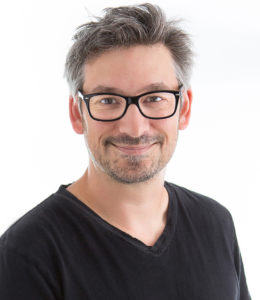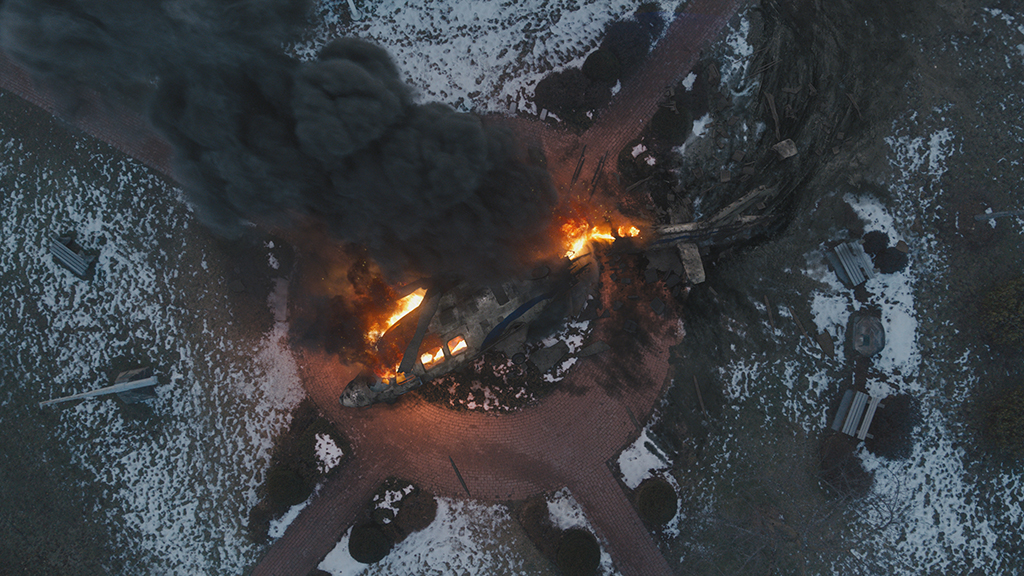By TREVOR HOGG

By TREVOR HOGG

Long before the continuity of the Marvel Cinematic Universe, Stephen King created an interconnected literary world with the fictional town of Castle Rock, Maine, which has served as the setting for a number of his stories starting with The Dead Zone in 1979. Inspired by the idea of building a television series that interweaves the various characters and situations conceived by the famous horror author, Sam Shaw and Dustin Thomason collaborated with Hulu and J.J. Abrams’ Bad Robot Productions to produce Castle Rock. Fans of King will notice that connections extend to cast members who previously starred in film adaptations, such as Sissy Spacek (Carrie) as the mentally unstable adoptive mother of social-outcast lawyer Henry Deaver (Andre Holland), and Bill Skarsgård (It) as the mysterious and unaccounted for Shawshank Prison inmate who may well be the human personification of evil.
Locations had to be weaved into the lore of how Stephen King described Castle Rock. “I worked with Sam Shaw and Dustin Thomason on their previous show, Manhattan,” states FuseFX Visual Effects Supervisor Jason Piccioni. “I have a good sense of their tone and what they want to do. This town wasn’t going to feel like a visual effects show, like Agents of S.H.I.E.L.D. Sam and Dustin wanted this organic, gritty feel to it, and the visual effects were going to come in when needed to enhance storylines or help out.” Orange, Massachusetts, doubles for downtown Castle Rock. “The town square is there, the bar, Henry’s house, Molly’s house, the church, cemetery and a few other places. Shawshank Prison is Moundsville Prison in West Virginia. We didn’t do too much world building in Orange itself. We had some weather issues. J.J. Abrams handpicked Orange, and the local residents were supportive, so we were able to shoot there without too much trouble the entire time.” The majority of principal photography was shot on location with sets built for the basement of Shawshank Prison and parts of Henry’s house.


“Because the production shot over a number of seasons, we were aware of the weather and the challenges it would bring,” notes Piccioni. “There were days where we shot scenes that needed to be in the snow followed by ones that didn’t. The special effects team would shovel snow in and out. We had quite a bit of CG-enhanced snow as well. The big sequence that opens the season takes place on a frozen lake, but the on-location lake wasn’t frozen at the time.” The decision was made to produce a CG version utilizing the HDRIs, reference photos and the same sky. “We had to decide how reflective and how much snow should be on the lake. It turns out when lakes freeze and then there’s snow, it’s a complete white blanket. Even though the lake did end up freezing later during production, it wasn’t that interesting to use. “The biggest thing that we had to do during prep,” Piccioni continues, “was mentally piece together where all of the locations were, how they were going to overlap with each other, what the time periods were and what the seasons were going to be. We had a big board [of cues]: ‘This is where this scene goes, and it’s in this time period. We have to go from here to there. What does that mean? How do we transition?’ Those were the big things that we had to go along with. We would sit in the room with the directors and ADs, try to map out everything as the scripts were being written, and tried to figure out all of the permutations for every change we wanted to make. 
“In the fifth episode there’s a forest fire, so most of those skies were enhanced and replaced to feel the smoky claustrophobia of what was happening in that town. … All of the birds are CG, and there are a lot more of them as the season progresses. They’re a combination of hero CG fully-rigged feathered birds and some particle flocking in Houdini.” —Jason Piccioni, Visual Effects Supervisor, FuseFX

“In the fifth episode there’s a forest fire, so most of those skies were enhanced and replaced to feel the smoky claustrophobia of what was happening in that town,” remarks Piccioni. “The rest of it is New England in the winter.” Crows were digitally added. “All of the birds are CG, and there are a lot more of them as the season progresses. They’re a combination of hero CG fully-rigged feathered birds and some particle flocking in Houdini.” As for the tiny furry creature that The Kid (Skarsgård) appears to telepathically drive to its demise, no CG was needed. “That was a real mouse. It was three hours of watching this poor woman on the floor making funny sounds to get her mouse to run across our prison set. We used a dummy mouse in the trap.” Visual effects assisted with time-period transitions. “There were a couple of times, especially in the first few episodes, where we were trying to get the camera to take us into these little vignettes of Castle Rock to show what happened in this town and why it might be so cursed,” explains Piccioni. “The town is a character. We didn’t want an on-screen transition. We wanted to be in one room, like in Molly’s house, Steadicam our way out of the door and be in a different room – but it’s daytime and 50 years in the past. We used some compositing tricks, as well as poor man’s motion control, to seam together a couple of Steadicam passes and make them feel like they’re one piece.” Blood and gore were meant to push the story forward. “In the second episode in the montage, with the mascot committing suicide by jumping off the high school, there was a lot of art direction about the blood on that one,” Piccioni relates. “We didn’t necessarily have an agenda to make things super gory or not.” 

“The warden’s suicide was on our first day of photography, and we launched a car off a cliff. Just once, thankfully. That cliff is shot in a rock quarry which is a small pond, and we did some CG water and matte paintings to make it feel like it’s part of the larger Castle Lake, which we’ll see later in the story. It’s also a dangerous cliff, so we had a duplicate of that on a greenscreen stage for when characters got near the cliff edge.” —Jason Piccioni, Visual Effects Supervisor, FuseFX

A fair number of digital doubles were produced. “We did a digital double on the mascot suicide as well as for the frozen lake scene.” Set extensions were done for Shawshank Prison and the Castle Lake environment where in the first episode the warden drives off the cliff. “The warden’s suicide was on our first day of photography, and we launched a car off of a cliff. Just once, thankfully. That cliff is shot in a rock quarry which is a small pond, and we did some CG water and matte paintings to make it feel like it’s part of the larger Castle Lake, which we’ll see later in the story. It’s also a dangerous cliff, so we had a duplicate of that on a greenscreen stage for when characters got near the cliff edge.” 
“This town wasn’t going to feel like a visual effects show, like Agents of S.H.I.E.L.D. [Executive Producers Sam Shaw and Dustin Thomason] wanted this organic, gritty feel to it, and the visual effects were going to come in when needed to enhance storylines or help out.” —Jason Piccioni, Visual Effects Supervisor, FuseFX



“Like with anything that goes straight to series, there are challenges in trying to figure out what the show is while you’re doing the show.” —Jason Piccioni, Visual Effects Supervisor, FuseFX
Video was played back in camera for the security monitor room scene where it looks like The Kid has escaped his cell, leaving a path of dead prison guards. “We spent weeks piecing together little pieces of footage, we played it back, shot it, and then changed them in visual effects by re-burning all of the monitors,” states Piccioni. “There was a little bit of color in those monitors. Some of them are pure black and white. Richard Rutkowski, our DP, had this cool idea that the monitors were tinted a bit differently because they were so old. There’s a lot of green in a couple of those monitors. The cellblocks had more color than the visitor’s room.” Piccioni works for FuseFX, which was the sole vendor of the 1,000 visual effects shots. “FuseFX is one of the only places that can do and control a whole show of this size, which alleviated pipeline, editorial and budgeting concerns. FuseFX also did Sam and Dustin’s first show, Manhattan, so there was a great familiarity with the team there.”



The visual effects work increased rather than diminished. “When I started Castle Rock, they told me that the first episode was going to be big and then it was going to tail off. That did not happen at all. We knew that the weather was going to be a challenge. Getting the timeframes correct turned out to be less work because of the art department. Like with anything that goes straight to series, there are challenges in trying to figure out what the show is while you’re doing the show.” Despite the learning curve, the experience had a positive impact. “Sam and Dustin are such a pleasure to work with, and it’s my first work with Bad Robot, so that was a lot of fun. It’s partly the writing, partly the Stephen King lore, and the reactions we’re getting. Hopefully, the next project is the same project – do another season and work our way through the stories we want to tell, and investigate more of Stephen King’s mind. It’s been a pleasurable show to be a part of.”